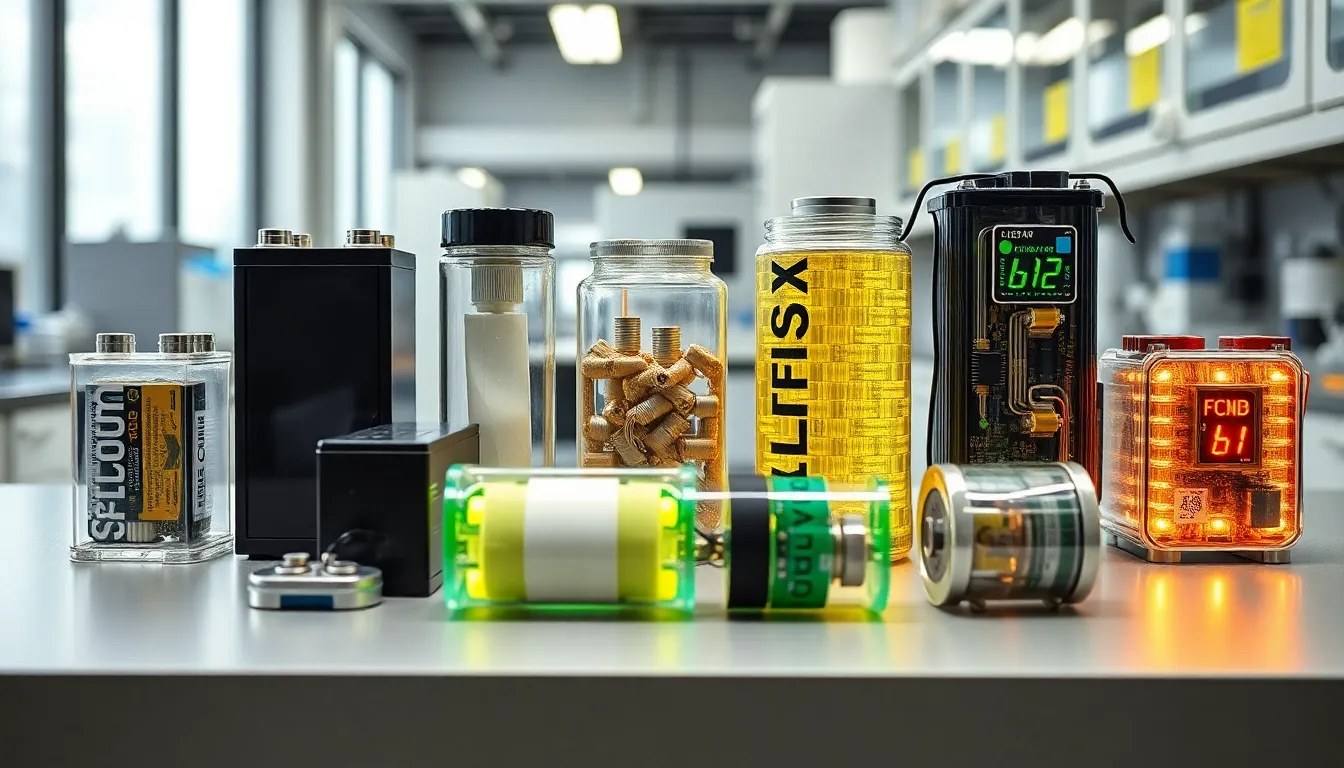Table of Contents
ToggleIn a world where our devices seem to have an insatiable appetite for power, sustainable battery technology is stepping up to the plate like a superhero in a cape—if that superhero were made of recycled materials and emitted zero harmful emissions. As the demand for energy storage skyrockets, the quest for greener alternatives has never been more crucial. Imagine a future where your smartphone charges faster than your coffee brews, all while leaving Mother Earth a little happier.
Overview of Sustainable Battery Technology
Sustainable battery technology plays a critical role in addressing energy storage needs. This innovation focuses on creating batteries that rely on eco-friendly materials, aiming to minimize environmental impact. Lithium-ion batteries dominate the market, although their production raises concerns regarding resource extraction and waste.
Recycling efforts for batteries significantly enhance sustainability. Companies develop methods to recover valuable materials such as lithium, cobalt, and nickel, reducing the need for new mining. Green chemistry principles guide researchers to design batteries using abundant materials and non-toxic substances.
Innovative solutions emerge in the form of alternative battery types. Solid-state batteries promise greater energy density and safety features compared to traditional lithium-ion options. Other promising technologies include sodium-ion batteries, which utilize sodium as a more sustainable alternative.
Fast charging capabilities are a primary focus in the development of sustainable batteries. Achieving quick charging without compromising battery life is essential for widespread adoption.
Researchers continuously explore advanced materials to improve performance. Graphene and organic compounds represent exciting possibilities in enhancing energy storage and minimizing environmental footprints.
Ultimately, sustainable battery technology addresses current energy challenges while paving the way for a greener future. As the demand for energy storage solutions persists, advancements in this field remain crucial for a sustainable society.
Types of Sustainable Battery Technologies

Sustainable battery technologies include several promising options designed to meet energy storage needs with eco-friendly approaches.
Lithium-Sulfur Batteries
Lithium-sulfur batteries offer a higher theoretical energy density than lithium-ion counterparts, potentially leading to more efficient energy storage. Utilizing sulfur, which is abundant and inexpensive, aligns well with sustainability goals. They produce less environmental impact compared to traditional batteries. Current challenges involve improving cycle life and performance under varying temperatures. Researchers focus on enhancing conductivity to extend durability and efficiency.
Solid-State Batteries
Solid-state batteries utilize solid electrolytes instead of liquid ones, enhancing safety by reducing fire hazards. These batteries allow for higher energy densities and faster charging times, making them attractive for electric vehicles and portable devices. The solid structure minimizes leakage, which contributes to their longevity. Despite the advantages, challenges involving manufacturing costs and materials remain. Innovations aim at overcoming these hurdles to achieve commercial viability.
Flow Batteries
Flow batteries provide flexible energy storage options through a liquid electrolyte system, enabling scalability for various applications. These systems excel in grid energy storage, making them suitable for renewable integrations like solar and wind. Longer discharge durations and the ability to recharge efficiently highlight their advantages. However, the existing limitations include higher upfront costs and reduced energy density compared to other batteries. Ongoing research targets cost reduction and performance improvements to increase adoption.
Benefits of Sustainable Battery Technology
Sustainable battery technology offers significant advantages, enhancing both environmental health and economic growth.
Environmental Impact
Sustainable batteries help reduce harmful emissions and pollution. Using recycled materials minimizes the extraction of finite resources, which protects ecosystems. Innovations in battery design, such as lithium-sulfur or solid-state batteries, lead to greater energy densities without compromising safety. Recyclability further ensures that valuable materials, like lithium and cobalt, remain in circulation, lowering overall environmental footprints. Transitioning to eco-friendly options reduces reliance on fossil fuels, minimizing carbon emissions during production and usage. These advancements collectively contribute to a cleaner, more sustainable future.
Economic Advantages
Sustainable battery technology also provides economic benefits. Lower raw material costs result from increased recycling efforts, which stabilize supply chains. Job creation spans various sectors, including recycling, manufacturing, and research. Investments in sustainable technologies lead to growth in emerging markets while attracting funding and partnerships. Reduced energy costs come from integrating renewable energy sources, making energy storage more affordable. As technologies improve and become more accessible, manufacturing processes may evolve, further decreasing costs and enhancing market competitiveness.
Challenges and Limitations
Sustainable battery technology faces several challenges that hinder its widespread implementation. Material sourcing issues and recycling concerns significantly impact progress in this field.
Material Sourcing Issues
Sourcing materials for sustainable batteries presents significant challenges. Many raw materials, such as lithium, cobalt, and nickel, rely on mining processes that harm the environment. Miners often work in regions with insufficient regulations, leading to social and environmental injustices. Limited availability of alternative materials compounds these issues, as research into substitutes must accelerate. Industries also grapple with fluctuations in material prices, which can disrupt supply chains. Ensuring ethical sourcing practices remains a priority to alleviate these concerns and improve the sustainability of battery production.
Recycling and Disposal Concerns
Recycling and disposal of batteries create additional hurdles in the sustainability quest. Existing recycling processes often lack efficiency, leaving a substantial portion of materials unrecovered. The presence of hazardous materials complicates proper disposal, posing risks to human health and the environment. Regulatory frameworks must evolve to support better recycling initiatives and safe disposal methods. Effective recycling systems can enhance resource recovery while minimizing waste, but current capabilities fall short. Manufacturers also need to design batteries with recyclability in mind to ensure a circular economy. Addressing these issues is vital for achieving long-term sustainability in battery technology.
Future Trends in Sustainable Battery Technology
Emerging trends in sustainable battery technology focus on innovation and efficiency. Companies are advancing research on lithium-sulfur batteries, harnessing their potential for higher energy density with lower environmental impact. Researchers are overcoming challenges associated with cycle life and temperature performance, increasing practicality for commercial use.
Solid-state batteries lead the way with their superior safety features and energy efficiency. Manufacturers are working to reduce production costs while increasing the scalability of solid-state solutions. Furthermore, sodium-ion batteries are gaining traction as a cost-effective alternative, leveraging abundant raw materials to mitigate resource scarcity concerns in lithium-ion batteries.
Market pressures continue to drive the evolution of fast charging technology. Users expect quick charging times without sacrificing battery longevity. Academic researchers are exploring advanced materials, such as graphene, which can enhance conductivity and performance while minimizing environmental harm.
Sustainability initiatives also prioritize developing effective recycling processes. Improving methods for recovering critical materials like lithium and nickel aims to ensure a circular economy within battery production. Companies are investing in recycling technologies that can address current inefficiencies, leading to better environmental outcomes.
Investments in flow batteries emphasize their scalability and compatibility with renewable energy sources. As demand for grid storage solutions grows, flow batteries offer a promising avenue for energy management and stability. Moreover, regulatory frameworks are evolving to support ethical sourcing practices, driving companies toward more sustainable material acquisition.
Technological advancements are reshaping the landscape of sustainable battery technologies. As these innovations mature, industries gain momentum, supporting a shift toward cleaner energy solutions. Comprehensive strategies addressing both production and end-of-life management foster a future where batteries contribute to a sustainable energy ecosystem.
Sustainable battery technology is paving the way for a greener future. As innovations continue to emerge, the potential for eco-friendly batteries grows stronger. These advancements not only address energy storage needs but also minimize environmental impacts.
The shift towards sustainable materials and efficient recycling processes is crucial for reducing reliance on harmful mining practices. With ongoing research into alternatives like solid-state and sodium-ion batteries, the industry is poised for significant transformation.
Investments in sustainable battery technologies promise economic benefits while protecting ecosystems. As the landscape evolves, the focus on ethical sourcing and improved manufacturing processes will be essential. This journey towards sustainability in battery technology is not just a trend; it’s a necessary evolution for a cleaner, more sustainable energy ecosystem.




